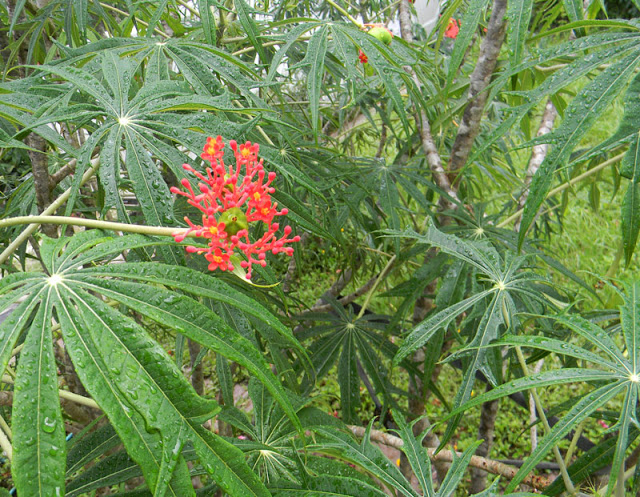I saw this coral plant growing in Hollywood and didn’t know what it was:
I could tell by the flowers, stems, leaf structure, white sap and tri-lobed fruit that it was in the Euphorbiaceae family… but I didn’t know the specific plant name.
Since I couldn’t leave it alone, and because I have a love for cassava, chaya, and a few other members of the spurge family, I nabbed a bunch of seeds and took a few cuttings. When I got home and did a little searching, I discovered it was called the “Coral plant,” known more specifically as Jatropha multifida.
Other than being pretty, it’s apparently a useless and toxic plant. (Of course – we know better than that! Pretty much every plant does something worthwhile… it’s just that some of those uses haven’t been discovered yet.)
These are only supposed to grow in USDA zone 10, but I’m going to try them in my home food forest anyhow. What do I have to lose? The seeds were free.
UPDATE: I added the coral plant to my list of plants that look like marijuana.



6 comments
I totally agree with you, David. All plants have their worth. We just haven't discovered it all. I never heard of the coral plant, but I like the flowers.
I grew this in S.W. Florida. It is a great pollinator plant. But be ready for curious onlookers, as it does resemble cannibis.
I grew this in S.W. Florida. It is a great pollinator plant. But be ready for curious onlookers, as it does resemble cannibis.
It looks as though Jatropha multifida (“Coral plant”) does have some medicinal purposes (has been used in African folk medicine) if used properly and in the right dosage..otherwise it proposes some great risks:
http://www.inchem.org/documents/pims/plant/jmulti.htm
-“may contain hydrocyanic acid; may be a dermatitis producing resin; may be an alkaloid, and a glycoside which produce cardiovascular and respiratory depression=
Main risks and target organs-
Dehydration and cardiovascular collapse as a result of
haemorrhagic gastro-enteritis. Central nervous system
depression.
2.2 Summary of clinical effects-
Symptoms are largely those associated with gastro-intestinal
irritation. There is acute abdominal pain and a burning
sensation in the throat about half an hour after ingestion
of the seeds, followed by nausea, vomiting and diarrhoea.
The vomitus and faeces may contain blood. In severe
intoxications dehydration and haemorrhagic gastroenteritis can
occur. There may be CNS and cardiovascular depression and
collapse; children are more susceptible. ”
All that aside :)- it looks like it DOES have medicinal uses –
“The roots, stems, leaves seeds and fruits of the plant have been widely used in traditional folk medicine in many parts of West Africa. The seeds of J. curcas have been used as a purgative, antihelminthic and abortifacient as well as for treating ascites, gout, paralysis and skin diseases. The seed oil of the plant has been used as an ingredient in the treatment of rheumatic conditions, itch and parasitic skin diseases, and in the treatment of fever, jaundice and gonorrhoea, as a diuretic agent, and a mouth- wash. The leaf has been used as a haemostatic agent and the bark as a fish poison. In certain African countries people
are accustomed to chewing these seeds when in need of a laxative.
J. curcas seeds have been found to be highly effective against Strongyloides papillosus infection in goats (Adam & Magzoub, in press).
It has also been suggested that J. curcas seeds could be a useful chemotherapeutic agent provided that it is active at a non-lethal dose (Adam, 1974). This may be because of it’s reported antihelminthic activity. “
Thanks for the info. Many of the spurges are rather toxic, though fortunately they really don’t look tasty.
It’s an Iodine plant.
Comments are closed.